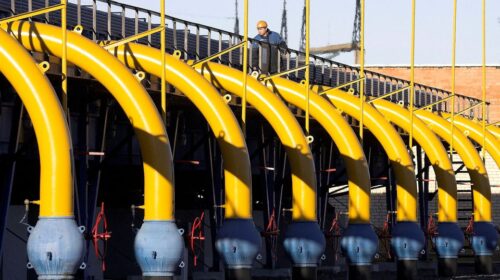Europe is now on the “safe side” with regard to gas supply this winter despite concerns over Russian deliveries, European Commission President Ursula von der Leyen said Feb. 16, amid the continued standoff between Moscow and the West over Ukraine.
We have, during the last weeks, looked into all possible disruption scenarios in case Russia decides to partially or completely disrupt gas supplies to the EU,” von der Leyen said.
“And I can say today that our models show, with all the measures we have taken, that we are now on the safe side for this winter,” she said.
“On top of this, we have also developed with a number of member states a new set of emergency measures which we could trigger in case of complete disruption,” she said.
European gas prices remain high on low storage levels and concerns over Russian supplies.
The TTF day-ahead price hit a record high of Eur182.78/MWh on Dec. 21, 2021, an increase of 985% year on year, according to S&P Global Platts price assessments.
Prices have cooled since and fell further on Feb. 15 amid signs of easing tensions along the Ukraine border.
The TTF day-ahead price was assessed at Eur68.08/MWh Feb. 15, down 14% on the day but still 315% higher than Eur16.35/MWh seen a year ago.

While stock levels are still low, withdrawals across Europe have slowed in recent weeks thanks to mild weather, leaving European storage sites in a healthier state than had been feared in December.
According to Gas Infrastructure Europe, storages across Europe were 33% full as of Feb. 14, compared with 41% a year ago.
“Temperatures have been mild since Christmas and are forecast to remain mild in Northwest Europe through the balance of February, which — along with relatively mild weather in Asia — has been the most important factor in getting Europe through winter without emptying storage,” S&P Global Platts Analytics’ managing analyst James Huckstepp said Feb. 16.
“Continued demand switching, industrial destruction, and supply optimization — particularly from Norway — have also been critical to getting us into a much more comfortable position than we were in two months ago,” Huckstepp said.
Analysts at Commerzbank also believe the current state of stocks in Europe should be sufficient to last the remainder of the winter. “European storage facilities are currently still a third full, which should be enough to last until the end of the winter season,” they said in a note Feb. 16.
Related Infographic: Russia standoff puts spotlight on global oil and gas supply as Ukraine crisis grows
Gazprom behavior
Von der Leyen, meanwhile, said Europe was also “ready” in the event that the Russian leadership decided to “weaponize” the energy issue.
“We see that at a time of high demand that Gazprom is restricting its gas supplies to Europe,” she said.
“We see a 10-year low in storage by Gazprom, we see no sales on the spot market. This is strange behavior for a company that — in times of skyrocketing demand and prices — [is] not trying to maximize profits,” she said.
“This behavior has already damaged Russia’s credibility as a reliable energy supplier.”
Both Russia and Gazprom have denied deliberately withholding gas from Europe, saying repeatedly that they are supplying gas to Europe in line with contractual obligations.
However, the level of stocks in Gazprom sites in Europe is still low and there have been no spot sales on the company’s Electronic Sales Platform since October 2021.
Von der Leyen said the recent events also showed that Europe needed to reduce its dependence on Russian gas imports, comments that drew applause from the Parliament.
“One of the main lessons we can already learn from this crisis is that we must diversify our energy sources, and we must get rid of dependency on Russian gas,” she said.
Instead, she said: “We must heavily invest in renewable energy sources.”
Alternative suppliers
Concerns over Russian gas supply to Europe have seen the EC also make significant diplomatic efforts in recent weeks to seek additional gas deliveries from alternative suppliers.
EC energy commissioner Kadri Simson has held talks with LNG powerhouse Qatar and Azerbaijan — supplier to the Southern Gas Corridor — this month, while Japan has also pledged to offer Europe surplus LNG cargoes.
In addition, EC executive vice president Margrethe Vestager met with Nigerian vice president Yemi Osinbajo in Abuja Feb. 14, with both parties agreeing to consider “all options” for increased supply of LNG from Nigeria to the EU.
“We are in talks with a number of countries that are ready to step up their exports of LNG to the EU,” von der Leyen said.
“This resulted in January [seeing] record deliveries of LNG,” she said.
She said EU member states had also invested in more LNG import infrastructure and strengthened the pan-European pipeline network since the annexation of Crimea in 2014.
“And the good part in this story is that these investments in infrastructure we have done will in future be the backbone for the possibility to supply green hydrogen. They are future-proof,” she said.
e TTF day-ahead price was assessed at Eur68.08/MWh Feb. 15, down 14% on the day but still 315% higher than Eur16.35/MWh seen a year ago.






